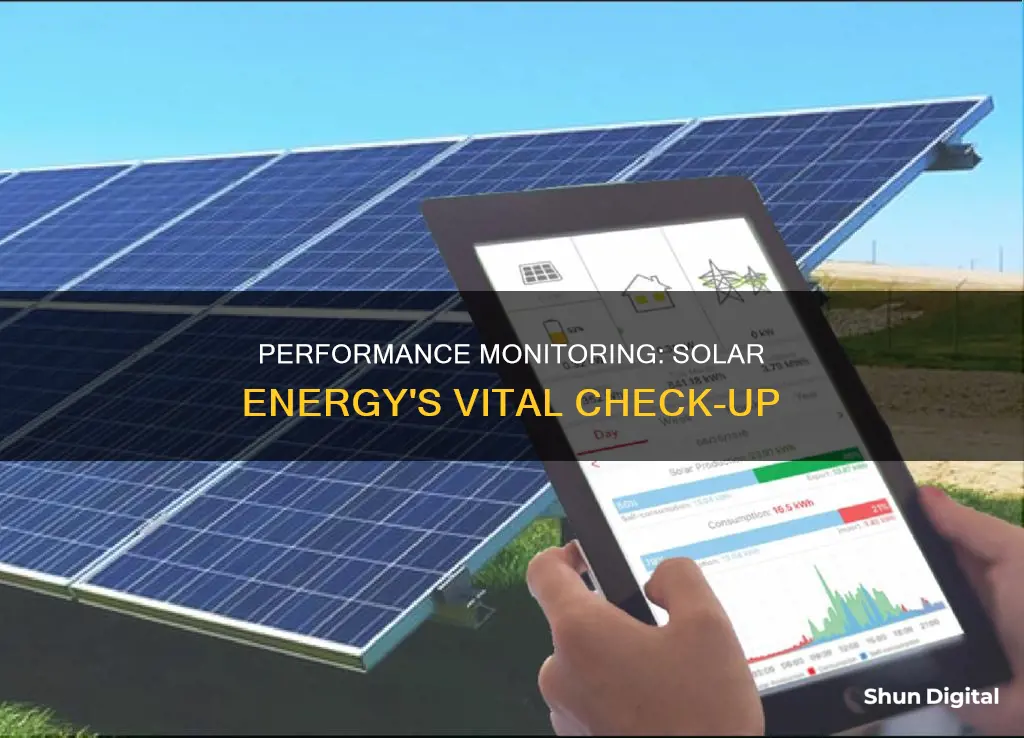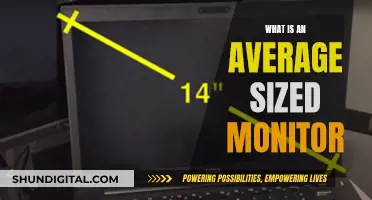
Solar panel performance monitoring systems are designed to track and analyse solar panel performance and home energy use. They collect real-time data on parameters such as energy production, voltage, current, weather conditions, and usage patterns. This data is then used for several purposes, including technical (failure detection and creating a performance baseline), operational (scheduling service and cleaning), and financial (increasing income and reducing the risk profile).
Solar monitoring systems can be installed at the same time as solar panels or as an aftermarket solution. They include hardware attached to a solar array, an internet connection, and software such as a phone app or web portal. The hardware might also measure solar radiation and other weather data.
Solar monitoring systems are important because they allow users to detect errors or hardware defects, monitor current system output, and compare panel output over time. This information can be used to increase energy efficiency and save money.
| Characteristics | Values |
|---|---|
| Purpose | To accurately monitor system performance |
| Technical Benefits | Failure detection, creating a performance baseline |
| Operational Benefits | Scheduling service and cleaning |
| Financial Benefits | Increase income, reduce risk profile, sale of the PV power plant |
| Data Collection | Sensors, pyranometers, pyrheliometers, power conditioning equipment, additional instrumentation |
| Electrical Measurements | Real power, reactive power, voltage, current |
| Environmental Measurements | PV module temperature, weather data, satellite data |
| Features | Calculations and analysis, reports of key performance indicators, financial calculations, errors and alarms, maintenance tickets, interface with utility or larger system, curating project documents |
| Costs | $1,000-$5,000 for instrumentation, $0-$100/year for residential/commercial systems, up to $50,000/year for large utility-scale plants |
What You'll Learn

Solar panel performance monitoring systems
There are two main types of solar panel monitoring: built-in inverter monitoring and third-party monitoring. Built-in inverter monitoring is commonly found in modern solar systems. Solar inverters convert DC power generated by solar panels into AC power and have built-in energy monitoring capabilities. They collect data on parameters like energy production, voltage, and current, and transmit it to a central monitoring platform. This type of monitoring is typically included with the solar system and does not require additional hardware.
Third-party monitoring, on the other hand, involves the use of external monitoring systems or devices that are independent of the inverters. These monitoring systems may offer more advanced features and analysis capabilities. They often use additional sensors or monitoring devices installed at the module or string level to collect more detailed data.
Solar panel monitoring systems can also be categorised into three types based on their providers: solar monitoring from equipment manufacturers, solar monitoring from installers, and standalone home energy monitors. Equipment manufacturers like Enphase, SolarEdge, and SMA provide monitoring as part of their products. Solar monitoring from installers refers to monitoring software offered by solar installers, which is often a re-skinned version of equipment manufacturer offerings. Standalone home energy monitors are provided by companies that don't manufacture solar equipment or install solar panels. These solutions offer additional features that allow for more granular energy usage monitoring.
RF Monitor Buying Guide: Where to Purchase
You may want to see also

Solar radiation measurement
Solar radiation is a mix of various types of radiation. The sun emits radiation according to the following distribution: 49% infrared, 43% visible light, 7% ultraviolet, and less than 1% radio waves, microwaves, x-rays, and gamma rays.
Solar irradiance is the power per unit area (surface power density) received from the Sun in the form of electromagnetic radiation. It is measured in watts per square meter (W/m2) in SI units. Irradiance can be measured in space or at the Earth's surface after atmospheric absorption and scattering. Irradiance on the Earth's surface depends on the tilt of the measuring surface, the height of the Sun above the horizon, and atmospheric conditions.
There are several types of solar irradiance:
- Total solar irradiance (TSI) is a measure of solar power over all wavelengths per unit area incident on the Earth's upper atmosphere.
- Direct normal irradiance (DNI), or beam radiation, is measured at the surface of the Earth at a given location with a surface element perpendicular to the Sun direction. It excludes diffuse solar radiation.
- Diffuse horizontal irradiance (DHI), or diffuse sky radiation, is the radiation at the Earth's surface from light scattered by the atmosphere.
- Global horizontal irradiance (GHI) is the total irradiance from the Sun on a horizontal surface on Earth. It is the sum of direct and diffuse horizontal irradiance.
- Global tilted irradiance (GTI) is the total radiation received on a surface with a defined tilt and azimuth, fixed or Sun-tracking.
- Global normal irradiance (GNI) is the total irradiance from the Sun at the surface of the Earth at a given location with a surface element perpendicular to the Sun.
The fraction of solar energy intercepted by the Earth is characterized by the solar constant, currently estimated at 1361 W/m2. This value varies by about 3% because the Earth's orbit is elliptical, and the distance from the Sun changes over the year.
When solar radiation passes through the Earth's atmosphere, several processes reduce the energy flux density:
- Absorption by particles and molecules in the atmosphere (10-30%)
- Reflection and scattering back into space (2-11%)
- Scattering to Earth, where direct radiation becomes diffuse (5-26%)
As a result, the direct radiation reaching the Earth's surface never exceeds 83% of the original energy flux. This direct radiation is known as beam radiation, while the scattered and reflected radiation that reaches the Earth's surface from all directions is called diffuse radiation. The sum of these components is called total or global radiation.
Several instruments are used to measure solar radiation:
- Pyrheliometers measure direct beam radiation at normal incidence.
- Pyranometers measure total hemispherical radiation (beam plus diffuse) on a horizontal surface. If shaded, they measure diffuse radiation.
- Photoelectric sunshine recorders measure the duration of bright sunshine at a locale.
Enlarging Your Monitor Display: Simple Steps to Increase View Size
You may want to see also

Benefits of solar monitoring
Solar monitoring systems offer a multitude of benefits for homeowners and businesses. Here are some key advantages:
Increased Awareness of System Operations
Solar monitoring allows you to easily check how much solar power your system is producing and how each panel and inverter are performing. This information helps you determine if any components require maintenance or if their productivity can be enhanced. The monitoring system provides real-time data, ensuring you always know how your system is performing. This knowledge gives you peace of mind and helps you maintain optimal efficiency.
Prompt Issue Identification and Resolution
Solar monitoring systems can detect and notify you of problems with solar panels, allowing for quick resolution before the system experiences downtime. Many systems use email or mobile app alerts to inform you of any issues, enabling you to take preventive measures and schedule maintenance promptly. This proactive approach helps keep your system running smoothly and reduces the risk of unexpected breakdowns.
Enhanced Energy Management
With solar monitoring, you can compare your home's power consumption, including peak usage periods, with the energy produced by your solar system. This comparison allows you to make informed decisions about your energy usage, such as when to schedule energy-intensive activities or optimize appliance use. As a result, you can better manage your energy consumption and increase your self-sufficiency.
Financial Benefits
By closely tracking the performance of your solar panels, you can identify any issues affecting your energy production and take prompt action. This helps maximize the efficiency and output of your system, reducing the need to purchase electricity from the grid and potentially lowering your utility bills. Additionally, solar monitoring can aid in assessing the financial benefits of your solar investment by comparing solar energy production with energy consumed.
Weather Insights and Preparedness
Solar monitoring systems can track historical weather data, allowing you to understand how weather patterns impact energy production. This information enables you to forecast how ongoing weather conditions might affect your solar panels' performance and plan accordingly. Some systems even provide weather alerts for low-sunlight days or incoming storms, helping you ensure you have enough stored solar power for emergencies.
Understanding MacBook Pro's Monitor Size Options
You may want to see also

Types of solar monitoring systems
Solar monitoring systems are available from solar equipment manufacturers, professional installers, and third-party monitoring companies. Here is an overview of the three main types:
Equipment-Integrated Solar Monitoring:
Manufacturers may offer inverter monitoring software or build monitoring systems into their solar panels or inverters (devices that convert DC output from panels into AC power for your home). Inverter monitoring systems are more common and typically offer easy-to-read results on websites or mobile apps. They track energy production, basic home energy use, and system performance data.
Installer Solar Monitoring:
Some installers offer monitoring apps with their energy systems, providing insights into daily production and upcoming electric bills. The apps may also offer online payment options and direct connections to customer support for troubleshooting and maintenance scheduling. Installer-based apps may not provide as much detail as module-level systems.
Third-Party Home Energy Monitors:
Third-party systems are offered by companies that don't manufacture solar equipment or provide installation services. They focus on your entire home's energy usage, not just solar, by using sensors attached to your electrical panel to track energy flow. They can monitor individual major appliances and integrate with smart home devices. These systems usually provide cost analysis, historical trends, and alerts for unusual energy spikes. They complement existing solar monitoring systems, offering solar-specific features, although the level of integration may vary.
Is Your Monitor Clamp-Compatible?
You may want to see also

Solar monitoring hardware
One type of solar monitoring hardware is the inverter, which converts the DC power generated by solar panels into AC power for household use. Inverter-based monitoring systems are commonly built into solar panels or the inverter itself, offering easy-to-read data on websites or mobile apps. Microinverters, for example, are small boxes that attach to the back of each solar module, allowing each panel to produce as much electricity as possible, even when others are shaded or defective. They also enable module-level monitoring, providing detailed analytics for each panel. String inverters, on the other hand, are connected to multiple panels and typically do not offer module-level monitoring.
Another type of solar monitoring hardware is the power optimiser, which is installed at the module level to optimise the power output of individual panels. Power optimisers enhance monitoring capabilities by providing real-time voltage, current, and performance data. They also improve overall panel performance by allowing panels to operate independently of each other.
Charge controllers are another important component of solar monitoring hardware, particularly for off-grid systems. These controllers monitor the state of charge of batteries, as well as energy input from solar panels and energy consumption, to ensure optimal battery performance and prevent overcharging or excessive discharge.
Additionally, monitoring hardware may include current transformers (CTs) or current transfer sensors, which are attached to electrical circuits to track energy flow and provide detailed energy use tracking.
Overall, solar monitoring hardware plays a crucial role in ensuring the optimal performance of solar energy systems, allowing users to identify and address any issues promptly, maximise energy production, and make informed decisions about their energy consumption.
Customizing Your Monitor: Shrinking Sidebar Size
You may want to see also
Frequently asked questions
Performance monitoring in solar energy involves the use of systems or devices to track and analyze the performance of solar panels and overall solar energy systems. These systems collect real-time data on various parameters such as energy production, voltage, current, weather conditions, and usage patterns.
Performance monitoring helps maximize the efficiency and output of solar panels by enabling early detection and troubleshooting of any issues. It also allows for financial analysis, such as calculating the financial performance of a solar system and identifying opportunities for optimizing energy usage to save costs.
Performance monitoring systems use sensors and communication devices attached to solar arrays. These sensors collect data on parameters like energy production, voltage, and current, and transmit it to a central monitoring platform or software application. This data can then be accessed and analyzed by system owners or operators, often through user-friendly interfaces or mobile apps.







